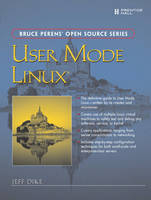
User Mode Linux
Prentice Hall (Verlag)
978-0-13-186505-1 (ISBN)
- Titel ist leider vergriffen;
keine Neuauflage - Artikel merken
With User Mode Linux you can create virtual Linux machines within a Linux computer and use them to safely test and debug applications, network services, and even kernels. You can try out new distributions, experiment with buggy software, and even test security. Now, for the first time, the creator and maintainer of User Mode Linux shows how to put it to work hands-on. Jeff Dike covers everything from getting started through running enterprise-class User Mode Linux servers. You'll find authoritative advice on bootup, compilation, administration, specialized configurations, and much more.
Coverage includes
What User Mode Linux is, how it works, and its uses in Linux networks
Key applications, including server consolidation, development, and disaster recovery
Booting and exploration: logins, consoles, swap space, partitioned disks, and more
Copy-On-Write (COW): UML's efficient approach to storing filesystem changes
In-depth discussion of User Mode Linux networking and security
Centrally managing User Mode Linux instances, and controlling their hardware resources
Implementing clusters and other specialized configurations
Setting up User Mode Linux servers, step-by-step: small-scale and large-scale examples
The future of virtualization and User Mode Linux
Whether you're a netadmin, sysadmin, teacher, student, or programmer, User Mode Linux®--the technology and this book--is indispensable.
Jeff Dike, an engineer at Intel, is author and maintainer of User Mode Linux. Well known throughout the Linux technical community, he has been active in Linux kernel development for more than five years. He holds a degree in Computer Science and Engineering from MIT.
Preface ix
Acknowledgments xi
About the Author xiiiChapter 1: Introduction 1
What Is UML? 1
Comparison with Other Virtualization Technologies 2
Why Virtual Machines? 3
A Bit of History 4
What Is UML Used For? 8
The Future 14
Chapter 2: A Quick Look at UML 17Booting UML for the First Time 20
Booting UML Successfully 24
Looking at a UML from the Inside and Outside 29
Conclusion 37
Chapter 3: Exploring UML 39Logging In as a Normal User 39
Consoles and Serial Lines 40
Adding Swap Space 47
Partitioned Disks 49
UML Disks as Raw Data 53
Networking 54
Shutting Down 59
Chapter 4: A Second UML Instance 61COW Files 61
Networking the UML Instances 71
A Virtual Serial Line 79
Chapter 5: Playing with a UML Instance 83Use and Abuse of UML Block Devices 83
Networking and the Host 87
Chapter 6: UML Filesystem Management 101Mounting Host Directories within a UML 101
Host Access to UML Filesystems 114
Making Backups 116
Extending Filesystems 117
When to Use What 118
Chapter 7: UML Networking in Depth 121Manually Setting Up Networking 121
The UML Networking Transports 142
An Extended Example 155
Chapter 8: Managing UML Instances from the Host 167The Management Console 167
Controlling a UML Instance with Signals 188
Chapter 9: Host Setup for a Small UML Server 191Host Kernel Version 192
UML Execution Modes 194
Managing Long-Lived UML Instances 203
Networking 206
UML Physical Memory 206
Host Memory Consumption 208
umid Directories 209
Overall Recommendations 209
Chapter 10: Large UML Server Management 211Security 212
Jailing UML Instances 216
Providing Console Access Securely 223
skas3 versus skas0 225
Future Enhancements 226
Final Points 232
Chapter 11: Compiling UML from Source 233Downloading UML Source 234
Configuration 235
Compilation 249
Chapter 12: Specialized UML Configurations 251Large Numbers of Devices 252
Clusters 265
UML as a Decision-Making Tool for Hardware 273
Chapter 13: The Future of UML 275The externfs Filesystem 277
Virtual Processes 282
Captive UML 283
Virtualized Subsystems 295
Conclusion 298
Appendix A: UML Command-Line Options 301Device and Hardware Specifications 301
Debugging Options 303
Management Options 304
Informational Options 305
Appendix B: UML Utilities Reference 307humfsify 307
uml_moo 308
uml_mconsole 308
tunctl 310
uml_switch 311
Internal Utilities 312
Index 313
| Erscheint lt. Verlag | 20.4.2006 |
|---|---|
| Reihe/Serie | Bruce Peren's Open Source Series |
| Verlagsort | Upper Saddle River |
| Sprache | englisch |
| Maße | 178 x 236 mm |
| Gewicht | 660 g |
| Themenwelt | Informatik ► Betriebssysteme / Server ► Unix / Linux |
| ISBN-10 | 0-13-186505-6 / 0131865056 |
| ISBN-13 | 978-0-13-186505-1 / 9780131865051 |
| Zustand | Neuware |
| Haben Sie eine Frage zum Produkt? |
aus dem Bereich


